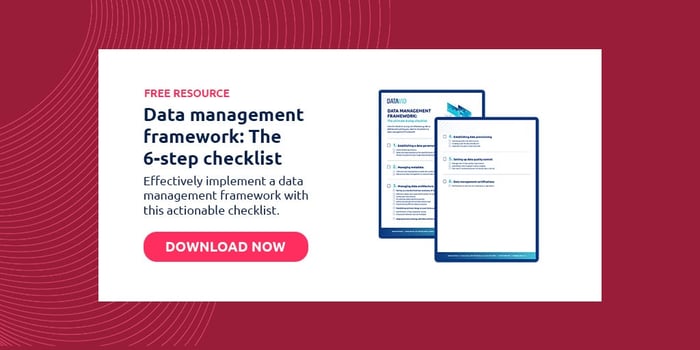5 minute read
3 examples of semantic data models that drive business value
Semantic data models help you discover valuable real-world relationships. Here are 3 examples of how you can use these models.
Table of contents
Semantic models improve the value of data by providing a shared language between underlying systems and the business user. Some examples are:
- Banks use semantic models to integrate customers’ interactions across channels, allowing them to provide a consistent customer experience.
- Healthcare providers extract relevant information from Electronic Health Records and matching it against synonyms and near-synonyms.
- Organisations automate back office tasks through Robotic Process Automation (RPA), where semantic data models extract entities to match against specific tasks.
Let’s look at each example in detail.
What’s obvious to me isn’t obvious to you. This is what happens when conversations start without a common context.
And it’s true in the world of data as well.
In the absence of shared context, one of 2 things will happen:
- Either the data is interpreted correctly (by chance), or;
- It will take up any meaning you assign to it.
Whatever the case, neither is ideal in a business setting.
Why semantic modeling matters
Semantic modeling matters when you want to capture more meaning out of your data. It defines data within the context of the real world and brings relationships to the surface.
(Often referred to as the “brain” of your enterprise architecture.)
A semantic data model is built upon concepts and meanings, unlike the traditional data model which is based on tables, columns, and rows.
But how do you get started on this semantic data modeling “journey”?
Approaches to semantic data modeling
Let’s look at what an entity is in semantics. If Maria studies at Harvard, then ‘Maria’ and ‘Harvard’ are all entities that are related through ‘study’.
There are several approaches for extracting this information in a simple, consistent, and independent manner from the business users’ perspective.
One of them is the Ontology model which identifies and describes business data, establishing existing relationships among the data.
Another is the Knowledge Graph, which represents real-world entities and the interdependence among them visually.

Three real-world examples of semantic data models
Here are some examples of semantic data models that provide business value to organisations in different fields such as banking and healthcare:
Example #1: Banking and financial institutions
Banks acquire customer data from an increasingly wide number of sources (e.g. online purchases, credit apps, social media) but this data exists in silos due to banks often having a product-oriented architecture.
This makes information harder to reach and analyse.
With increased digitisation and reduced offline banking, banks also struggle to provide a consistent and engaging customer experience as most customers no longer visit physical banks and have no face-to-face interaction with employees.
This makes it challenging for banks to redefine customer engagement by providing context-driven personalisation across all touch points available to them.
How semantics gets applied in banks
A well-designed semantic data model introduces a common business language understandable by everyone across the banking institution – including machines.
It places itself between the business user and the current banking infrastructure without changing the structural code.
The layer has knowledge graphs that map all the business objects together with the underlying relationships by using information not only stored in databases but from text documents as well.
SMEs (subject matter experts) from across the organisation collaborate to create knowledge graphs and to do so, they don’t have to start from the beginning.
They use FIBO (Financial Industry Business Ontology) to define business terms, processes, and transactions in the financial industry and map relationships. This way, a common vocabulary is provided to interpret any data.
Semantics enhancing customer experience
Banks use knowledge graphs to provide personalised recommendations by keeping in context your usual way of online banking interaction.
It’s the same technology that sits behind self-service portals.
From providing a personalised view of the dashboard to solving your query, and suggesting new services-all of it is semantics at play.
Ready-to-use templates for different use cases also provide faster resolution and cut support costs down by automating queries of repetitive nature.
Example #2: Healthcare
Conventional technology fails at managing the huge variety of disparate healthcare data. Creating a single definition of master data for healthcare is a big challenge.
An example is Electronic Health Records which are created from varied sources. This data could come from the patient’s clinical records, hospital lab results, wearable devices, and more. Here, a medical condition can be described in different ways.
For instance, “backache” for me is “spondylitis” in the medical practitioner’s language. If the data is not joined up with semantics, it could look like I suffer from two different medical conditions. But actually, there is only one.
Let’s consider another example of a medical emergency of a ‘heart attack’ which is ‘myocardial infarction’ in medical terminology.
People often use ‘cardiac arrest’ interchangeably for ‘heart attack’, however, both the conditions are different; though both are emergency situations.
This could result in an incorrect diagnosis resulting in wrong treatment and endangering the patient’s life.
Semantics brings strong interoperability to healthcare data
To achieve strong interoperability, semantics create a common vocabulary that assigns a common meaning to the health condition which goes in System 1 as “backache” and in System 2 as “spondylitis”.
It helps in defining synonyms and near-synonyms across anatomy, diseases, medical procedures, pharmaceuticals, etc.
The health record is exchanged across the systems following a standard model.
With the common terminology, it is easy to update records across the different systems capturing any health data, and those changes are reflected across all terms.
Example #3: Automation
Robotic Process Automation does very well in automating simple and repetitive tasks (e.g. back office work). But automation tools don’t do well when the data they deal with is unstructured, complex, and has implicit meaning.
These tools fail to scale as the data grows.
This is where semantics plays its role.
Semantics fill the gaps in automation tools
Semantic provides structure and meaning to integrated data.
An ontology-based approach reads and analyzes the unstructured information available across documents and establishes a relationship among data points.
This semantic understanding is then fed to automation tools to run their tasks.
How to use semantic data models in your project
To begin with, semantic data models, let’s consider three fundamental steps that any organisation can leverage as a starting point:
Step #1: Defining the business use case
This foundational step will provide clarity on the business goal that you want to achieve. Start with a single use case that has a low barrier to entry and clearly defined outcomes.
The business use case can help focus the views of both IT and the business.
By being directly involved, there’ll be a higher likelihood of success.
Step #2: Mapping your data with the model
Your data architecture might comprise various databases and data warehouses. Thankfully, semantic modeling does not require existing data assets to be modified.
Leveraging available semantic standards like FIBO, the Semantic Web, and others will provide best practices to easily add business context to your data.
Step #3: Leveraging proven semantic tools
Semantic tools will help in scaling up the whole process of creating a semantic data model. Designing Ontology models and creating enterprise knowledge graphs will result in easier storage, processing, and retrieval of your semantic data.
Consider the following tools:
- Datavid Rover: Powerful knowledge engine to build semantic data applications which integrate with other technologies such as MarkLogic.
- MarkLogic semantics: Stores metadata, improves data integration, and builds applications using integrated, highly-connected data.
- Ontotext: Enterprise knowledge graph technology and semantic database.
- Apache Jena: Open-source software for semantic web and linked data apps.
Semantic modeling: Where should you start?
Before you make a choice in favour of semantic data models, you need to look carefully at the business outcome you wish to achieve.
Through this post, I’ve attempted to help you build an understanding of how a semantic data model can power your enterprise data.
The benefits of having a common vocabulary facilitate easy data accessibility and quick application development—making your data a single source of truth.
However, the benefits shouldn’t be the ONLY driving factor to opt for it.
Clarity on whether it solves the data problem you struggle with as an enterprise will help you in moving ahead. If you wish to start on a semantic journey, I’d like you to explore our knowledge engine, Datavid Rover, for your data intelligence projects.
It provides added value to your data by removing data silos, gets you the right data from multiple sources, extracts and maps relevant concepts from your data repository, and much more.
I wish you all the best on your data intelligence journey.
Frequently Asked Questions
What is semantic data modeling?
Semantic data modeling is a method of structuring data by defining the real-world entities within it and their relationships from a business user’s perspective.
What is a knowledge graph?
A knowledge graph is a network of real-world entities (objects, situations, concepts) that demonstrates a relationship between them through a graph structure.
What are the benefits of semantic data modeling?
Semantic data modeling hides the complexity of underlying data, facilitates quick discovery and accessibility of business data, and simplifies end-user interaction.




